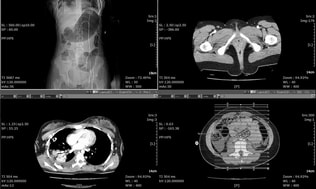Part 3: RPOC - Retained Products of Conception causing post-natal infection
In this series of articles, we are looking at birth injuries affecting the mother as opposed to the baby. The vaast majority of mothers give birth to healthy babies without any harm to the mother. On some occasions however, the outcome for the mother is not so good with injury occurring that may lead to short, medium or even long term consequence. In some, but certainly not all of these cases, the maternal injury was caused by neglect and it is to that neglect – and only in cases of clearly proven neglect, that the law addresses the issue of compensation.
It is somewhat of an aside but I often feel the cold breeze of unfair criticism on the back on my neck when I hear the medical profession disparage my profession for encouraging litigation. Whether you are a patient or a client, you are entitled to be told if your care has fallen below an acceptable level to the extent that it has harmed you. If the medical profession will not tell you the truth to patients – as it quite obviously and obstinately refuses to do – then it falls to the legal profession to help people get answers to questions about their medical treatment, and in appropriate cases, take action for some reasonable redress on their behalf.
Addressing again the issue of maternal injuries in childbirth, this second article in the series looks at what happens when in the course of a delivery, a part of the bowel or the bladder is perforated, how that injury occurs, what harm can arise from it and in what circumstances it constitutes a fall below the appropriate standard of care – what we call a ‘breach of duty’.
In childbirth the bowel and bladder do not get damaged in the course of a normal vaginal delivery. Such injuries can however occur in the course of a caesarian section (C-section) because the mother’s abdomen is opened by the surgeon and in the course of the dissection through to the baby inside the placenta, other organs must be moved or disturbed and sometimes this leads to a ‘perforation’ which is just another way of describing an hole or opening through which bladder or bowel contents may leak into the surrounding area of the abdominal cavity.
The leak of bladder contents is not typically as serious as the leak of bowel contents because urine is a sterile material whereas the bowel contains the faeces, 50% of which comprise dangerous E. coli bacteria and is more likely to lead to severe infection called ‘sepsis’ which is life-threatening. Nevertheless, both types of perforation need to be identified quickly and repaired.
The mere fact of a perforation is rarely regarded as a basis for a case in negligence because perforation is a known risk of such surgery. Like most things in law, this statement is qualified with exceptions but it is generally true – so long as the surgeon who is the gynaecologist/obstetrician has identified the perforation, repaired it and cleaned the abdominal cavity of leaked contaminants.
Unfortunately, a perforation is not always identified during the surgery. Instead, the mother’s abdomen is closed without a repair being done - presumably because the surgeon was unaware of the injury caused – and over the following days, an infection develops to the point that the mother becomes obviously unwell.
Such infections are sometimes detected while the mother is still in hospital though with modern post-natal care periods in hospital becoming shorter, an increasing number of such mothers are being diagnosed at a later stage. That is not to say they are always feeling well on discharge. We have come across a number of situations where the mother was voicing concerns about her own health prior to discharge from hospital but their concerns were dismissed.
Whether the infection is identified early or late is significant. Infections are progressive and early detection, leading to early treatment will typically lead to a shorter period of illness and a better outcome.
Late detection of such infections can lead to very serious consequences and quite apart from the infection itself, the perforation will generally require another opening of the abdomen to identify the perforation, repair it and washout the area. In the course of such an operation, other tissues might be identified as having been damaged by the infection and require to be cut away or ‘resected’. If a section of the large intestine or ‘colon’ has to be resected, then the surgeon will typically perform a colostomy which will typically be temporary and be reversed at a later stage although the procedure in certain circumstances may need to be permanent which is of course life altering for a young woman.
It is somewhat of an aside but I often feel the cold breeze of unfair criticism on the back on my neck when I hear the medical profession disparage my profession for encouraging litigation. Whether you are a patient or a client, you are entitled to be told if your care has fallen below an acceptable level to the extent that it has harmed you. If the medical profession will not tell you the truth to patients – as it quite obviously and obstinately refuses to do – then it falls to the legal profession to help people get answers to questions about their medical treatment, and in appropriate cases, take action for some reasonable redress on their behalf.
Addressing again the issue of maternal injuries in childbirth, this second article in the series looks at what happens when in the course of a delivery, a part of the bowel or the bladder is perforated, how that injury occurs, what harm can arise from it and in what circumstances it constitutes a fall below the appropriate standard of care – what we call a ‘breach of duty’.
In childbirth the bowel and bladder do not get damaged in the course of a normal vaginal delivery. Such injuries can however occur in the course of a caesarian section (C-section) because the mother’s abdomen is opened by the surgeon and in the course of the dissection through to the baby inside the placenta, other organs must be moved or disturbed and sometimes this leads to a ‘perforation’ which is just another way of describing an hole or opening through which bladder or bowel contents may leak into the surrounding area of the abdominal cavity.
The leak of bladder contents is not typically as serious as the leak of bowel contents because urine is a sterile material whereas the bowel contains the faeces, 50% of which comprise dangerous E. coli bacteria and is more likely to lead to severe infection called ‘sepsis’ which is life-threatening. Nevertheless, both types of perforation need to be identified quickly and repaired.
The mere fact of a perforation is rarely regarded as a basis for a case in negligence because perforation is a known risk of such surgery. Like most things in law, this statement is qualified with exceptions but it is generally true – so long as the surgeon who is the gynaecologist/obstetrician has identified the perforation, repaired it and cleaned the abdominal cavity of leaked contaminants.
Unfortunately, a perforation is not always identified during the surgery. Instead, the mother’s abdomen is closed without a repair being done - presumably because the surgeon was unaware of the injury caused – and over the following days, an infection develops to the point that the mother becomes obviously unwell.
Such infections are sometimes detected while the mother is still in hospital though with modern post-natal care periods in hospital becoming shorter, an increasing number of such mothers are being diagnosed at a later stage. That is not to say they are always feeling well on discharge. We have come across a number of situations where the mother was voicing concerns about her own health prior to discharge from hospital but their concerns were dismissed.
Whether the infection is identified early or late is significant. Infections are progressive and early detection, leading to early treatment will typically lead to a shorter period of illness and a better outcome.
Late detection of such infections can lead to very serious consequences and quite apart from the infection itself, the perforation will generally require another opening of the abdomen to identify the perforation, repair it and washout the area. In the course of such an operation, other tissues might be identified as having been damaged by the infection and require to be cut away or ‘resected’. If a section of the large intestine or ‘colon’ has to be resected, then the surgeon will typically perform a colostomy which will typically be temporary and be reversed at a later stage although the procedure in certain circumstances may need to be permanent which is of course life altering for a young woman.
|
Whatever the extent of the harm however, the legal investigative work we do in determining if the medical care fell below an acceptable standard is roughly
Similar. This failure of care is what we call a ‘breach of duty’ and it is only when an independent expert confirms this breach and that the harm or injury was caused or materially contributed to by this failure (in other words that the bad outcome would not have happened anyway, in the absence of the error) that we can bring legal proceedings on our client’s behalf. So in summary, perforations of bladder and bowel can occur in the ordinary course of a C-section and it does not mean the surgeon has been negligent. If however the C-section was not necessary or ought to have been avoided or if the perforation has not been identified and repaired during the surgery, then it will cause harm to the patient and that harm will in most cases be a case of negligence. In the next article, we will look at some medico-legal issues arising from the failure to deliver the placenta fully. |





